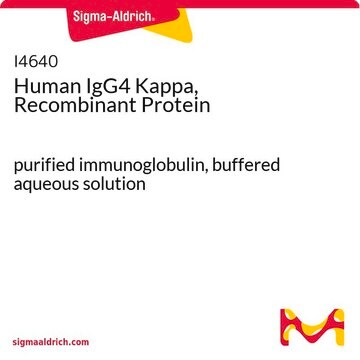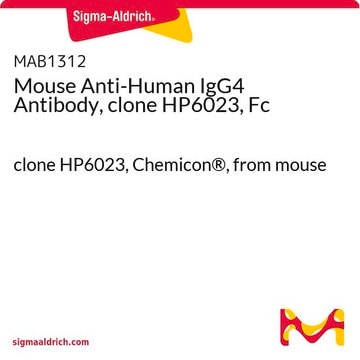411492
Mouse Anti-Human IgG₄, Fc Fragment Specific (HP6025)
liquid, clone HP6025, Calbiochem®
Sign Into View Organizational & Contract Pricing
All Photos(1)
About This Item
UNSPSC Code:
12352203
NACRES:
NA.46
Recommended Products
biological source
mouse
Quality Level
antibody form
purified antibody
antibody product type
secondary antibodies
clone
HP6025, monoclonal
form
liquid
does not contain
preservative
manufacturer/tradename
Calbiochem®
storage condition
OK to freeze
avoid repeated freeze/thaw cycles
isotype
IgG
shipped in
wet ice
storage temp.
−20°C
target post-translational modification
unmodified
General description
Purified mouse monoclonal antibody. Recognizes human IgG4 Fc fragment.
This Mouse Anti-Human IgG₄, Fc Fragment Specific (HP6025) is validated for use in Enzyme Immunoassay for the detection of Human IgG₄, Fc Fragment Specific.
Application
Enzyme Immunoassay (10 µg/ml, see application references)
Packaging
Please refer to vial label for lot-specific concentration.
Warning
Toxicity: Standard Handling (A)
Physical form
In PBS, pH 7.4.
Reconstitution
Following initial thaw, aliquot and freeze (-20°C). Avoid more than 5 freeze/thaw cycles.
Other Notes
Antibody should be titrated for optimal results in individual systems.
Cross-reactivity by ELISA against human myeloma proteins:
Human IgG1: ≤0.1%
Human IgG2: ≤0.04%
Human IgG3: ≤0.02%
Human IgG4: 100%
Human IgA: <0.1%
Human IgE: <0.1%
Human IgM: <0.1%
Cross-reactivity by ELISA against chimeric antibodies:
Human IgG1: <0.01%
Human IgG2: <0.01%
Human IgG3: <0.01%
Human IgG4: 100%
Human IgA: <0.01%
Human IgE: <0.01%
Human IgM: <0.01%
Cross-reactivity by ELISA against human myeloma proteins:
Human IgG1: ≤0.1%
Human IgG2: ≤0.04%
Human IgG3: ≤0.02%
Human IgG4: 100%
Human IgA: <0.1%
Human IgE: <0.1%
Human IgM: <0.1%
Cross-reactivity by ELISA against chimeric antibodies:
Human IgG1: <0.01%
Human IgG2: <0.01%
Human IgG3: <0.01%
Human IgG4: 100%
Human IgA: <0.01%
Human IgE: <0.01%
Human IgM: <0.01%
Hamilton, R.G. 1990. Ann. Biol. Clin.48, 473.
Fasullo, F.J., et al. 1989. Clin. Chem.35, 364.
Jefferis, R., et al. 1986. Immunol. Letters10, 223.
Fasullo, F.J., et al. 1989. Clin. Chem.35, 364.
Jefferis, R., et al. 1986. Immunol. Letters10, 223.
Legal Information
CALBIOCHEM is a registered trademark of Merck KGaA, Darmstadt, Germany
Not finding the right product?
Try our Product Selector Tool.
Storage Class Code
10 - Combustible liquids
WGK
WGK 1
Flash Point(F)
Not applicable
Flash Point(C)
Not applicable
Certificates of Analysis (COA)
Search for Certificates of Analysis (COA) by entering the products Lot/Batch Number. Lot and Batch Numbers can be found on a product’s label following the words ‘Lot’ or ‘Batch’.
Already Own This Product?
Find documentation for the products that you have recently purchased in the Document Library.
D C Houpt et al.
Infection and immunity, 62(7), 2857-2864 (1994-07-01)
Serum obtained from normal human subjects contains antibodies reactive in an enzyme-linked immunosorbent assay with the glucuronoxylomannan (GXM) of Cryptococcus neoformans. The frequency of occurrence of class-specific antibodies among normal subjects was 28% for immunoglobulin G (IgG), 98% for IgM
R G Keller et al.
Infection and immunity, 62(1), 215-220 (1994-01-01)
Previous studies found that normal human serum (NHS) contains an immunoglobulin G (IgG) antibody that mediates initiation of the classical complement pathway by nonencapsulated Cryptococcus neoformans. The present study used an enzyme-linked immunosorbent assay with whole nonencapsulated yeast cells as
S Sievers et al.
Clinical and experimental allergy : journal of the British Society for Allergy and Clinical Immunology, 47(8), 1057-1068 (2017-03-28)
Microarray-based component-resolved diagnostics (CRD) has become an accepted tool to detect allergen-specific IgE sensitization towards hundreds of allergens in parallel from one drop of serum. Nevertheless, specificity and sensitivity as well as a simultaneous detection of allergen-specific IgG4 , as
H Lu et al.
Infection and immunity, 61(6), 2400-2407 (1993-06-01)
The aims of this study were to determine the immunodominant antigens of Actinobacillus actinomycetemcomitans serotype b (Aab) for the different immunoglobulin (Ig) classes and subclasses and to determine the relative levels of these different Igs in serum. Seropositive early-onset periodontitis
Our team of scientists has experience in all areas of research including Life Science, Material Science, Chemical Synthesis, Chromatography, Analytical and many others.
Contact Technical Service








